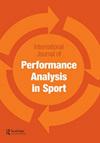Correlations between gaze fixations to different areas of interest are related to tennis serve return performance in two different expert groups
IF 1.6
4区 教育学
Q1 Health Professions
International Journal of Performance Analysis in Sport
Pub Date : 2021-09-19
DOI:10.1080/24748668.2021.1979840
引用次数: 2
Abstract
ABSTRACT Interceptive tasks, such as returning a tennis serve, require efficient use of visual information. The aim of this study was to investigate whether there are differences in the gaze behaviour in two different groups of tennis players. Additionally, analysis between tennis serve returns of different quality have been conducted. Six-hundred and seventy-five returns performed by ten national and five international level tennis players were analysed. Focal visual attention was measured on-court using a mobile eye-movement tracking device. Fixations were mapped to different areas of interest relative to five consecutive service phases. Differences in the duration of visual fixations between different types of tennis returns were examined as well as correlations between most relevant areas of interest. Correlation analysis revealed differences in visual search strategies between both groups of tennis players. The international level group presented with gaze behaviour that indicates increased attention to specific visual information in tactically more successful serve returns. The national level tennis players on the other hand presented less specific gaze behaviour, and probably overall, less efficient attentional control. Additionally, international level tennis players presented return performance-specific gaze behaviour in the follow through-phase, which was not observed for the national level players.在两个不同的专家小组中,注视不同感兴趣领域之间的相关性与网球发球回球表现有关
截击任务,如回网球发球,需要有效地利用视觉信息。这项研究的目的是调查两组不同的网球运动员的凝视行为是否存在差异。此外,还对不同质量的网球发球接发球进行了分析。研究人员分析了10名国家级和5名国际级网球运动员的675次击球。使用移动眼动追踪设备在球场上测量焦点视觉注意力。注视被映射到相对于五个连续的服务阶段的不同兴趣区域。在不同类型的网球击球之间,视觉注视持续时间的差异以及最相关的兴趣区域之间的相关性进行了研究。相关分析揭示了两组网球运动员在视觉搜索策略上的差异。国际水平组呈现凝视行为,表明在战术上更成功的发球中对特定视觉信息的关注增加。另一方面,国家水平的网球运动员表现出较少的特定注视行为,可能总体而言,注意力控制效率较低。此外,国际水平的网球运动员在跟进阶段出现了回球特定的注视行为,而在国家水平的网球运动员中没有观察到这一现象。
本文章由计算机程序翻译,如有差异,请以英文原文为准。
求助全文
约1分钟内获得全文
求助全文
来源期刊

International Journal of Performance Analysis in Sport
SPORT SCIENCES-
CiteScore
4.70
自引率
4.80%
发文量
38
审稿时长
>12 weeks
期刊介绍:
The International Journal of Performance Analysis in Sport aims to present current original research into sports performance. In so doing, the journal contributes to our general knowledge of sports performance making findings available to a wide audience of academics and practitioners.
 求助内容:
求助内容: 应助结果提醒方式:
应助结果提醒方式:


